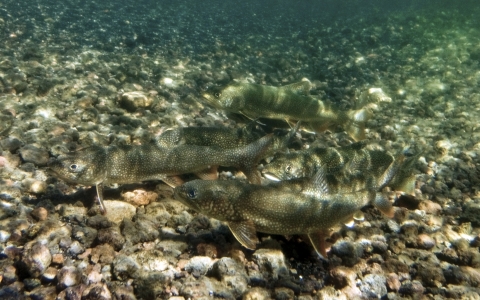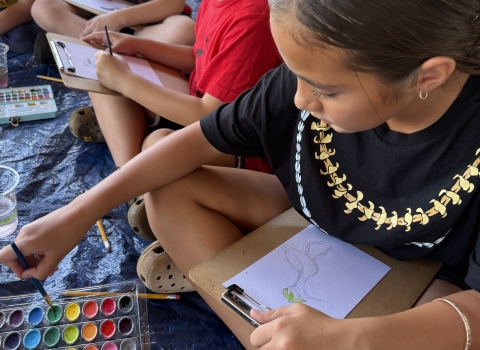If you reel in a lake trout from Lake Erie or Lake Ontario, there’s a good chance it was hatched at a national fish hatchery. Every spring, the U.S. Fish and Wildlife Service stocks more than 500,000 of these fish in the Great Lakes.
“We put them in as year-old fish and hope that they grow to adult size, begin spawning and replenish the lake’s population to develop a self-sustaining resource,” said Larry Miller, hatchery manager at Alleghany National Fish Hatchery in Pennsylvania.
Found in cool, northern waters, lake trout are known as a keystone species — as top predators, the fish help maintain ecological balance by keeping populations of other aquatic organisms under control. They also contribute to the Great Lakes fishery, which is valued at more than $7 billion dollars and supports more than 75,000 jobs each year.
Because of historical overharvesting, ongoing attacks by invasive sea lamprey and habitat degradation, lake trout populations in Lake Erie and Lake Ontario shrank to nothing by the mid-1960s.
Fortunately, stocking programs, sea lamprey control and the Clean Water Act of 1972 helped the species make great strides in the decades since. But the work isn’t done. Though populations are healthier now, they are still reliant on stocking — the number of wild-born lake trout is mysteriously low.
Successful stocking
Staff at Alleghany National Fish Hatchery have perfected rearing lake trout — they've had nearly 30 years of practice!
Because populations in Lake Ontario and Lake Erie were extirpated, biologists have experimented with genetic strains from neighboring lakes to see which will do best in stocking efforts. The hatchery currently raises lake trout with genetics from Seneca Lake, the Parry Sound in Lake Huron and Lake Champlain.
Before they release the young fish, hatchery biologists tag each one with a metal nose clip that carries information about their strain and when and where they were stocked.
“You inject it into the fish’s snout when they're young, and they'll carry it throughout their entire life,” Miller said. “It's unique because many times hatcheries raise fish, put them in the water and that's the last we ever know about them. But here, there's quite a bit of information that comes from a fish that is recaptured in the lake because of that tagging operation.”
By analyzing data from tags of fish that are caught, researchers can determine the survival rate for each stocking location and each genetic strain — key information to improve their processes and best help the populations recover.
While catch rates — the number of lake trout caught during research surveys — have fluctuated throughout the decades, the stocking programs have met adult abundance targets in Lake Ontario for the last 12 years and have been above or near targets in Lake Erie for the last eight years.
“Early on, the lake managers were asking for a lot of hatchery fish, almost 800,000 fish in Lake Ontario, but the program has been so successful in building up an adult stock population that they actually reduced it down to 320,000 fish,” Miller said. “The program has kind of met its goal, but they still haven't found adequate natural reproduction to have a self-sustaining population, so maintaining the adult population target will require continued stocking.”
After years of releasing hundreds of thousands of lake trout into the two lakes, something is still preventing a natural, wild-produced population from taking off.
Cracking the bottleneck
On the dark waters of Lake Ontario, a boat idles, and a camera drops overboard. It rests at the bottom of the lake and begins to film. Inside the boat, scientists watch on a monitor and capture images of the underwater ecosystem. Once they’re satisfied, they pull the camera up and continue to the next site.
They’re searching for clues to piece together the puzzle: What is bottlenecking wild lake trout reproduction?
For older fish, survival isn’t much of a concern — in Lake Erie, adult lake trout are the most abundant they’ve been since stocking began in 1986. The year-old hatchery fish also do well when released into the lakes. This has researchers curious about the first twelve months of a wild-born lake trout’s life and wondering how many new fish are hatching. One hypothesis has led biologists to investigate spawning grounds.
“We’re hoping to get a good idea of where they’re trying to spawn and whether the habitat is good or bad,” said Dr. Dimitry Gorsky, U.S. Fish and Wildlife Service biologist at the Lower Great Lakes Fish and Wildlife Conservation Office. “We’d like to understand what drives survival that first year from egg to yearling.”
The U.S. Fish and Wildlife Service is collaborating with New York State Department of Environmental Conservation, U.S. Geological Survey and Canadian agencies to find answers.
Using modeling, biologists identified more than 3,000 sites in Lake Ontario that might have characteristics of good spawning habitat. They’re visiting each location and collecting data with underwater photography.
Lake trout typically choose clean, rocky lake bottoms to spawn — they lay their eggs within the crevices between large stones, which protect the eggs from predation and currents that could sweep them away. Going site-to-site with underwater cameras, biologists check if preferred habitat is available or if erosion and runoff have altered it. Deforestation in the 1800s and onward caused excessive soil erosion, sending sediment into the lakes.
“We’re looking to identify if those good deep cracks are present or if they’ve been filled in by sediment,” Gorsky said.
Tracking wild lake trout
To collect the most accurate data on preferred spawning sites, the scientists consulted experts in the field: the lake trout themselves.
They inserted transmitters into approximately 400 lake trout in Lake Ontario. Using acoustic telemetry, they’ll track each fish’s movements throughout the lake for the next 10 years.
“We're hoping that the fish will swim around the lake during spawning time and identify different places that have potential to be really good spawning grounds,” Gorsky said. “Then we can follow up and evaluate the condition of the habitat.”
Given the low number of wild lake trout in Lake Ontario, most of the transmitters were placed in hatchery-raised fish, but the team was able to pull in a few wild trout to add to their sample, carefully inserting a transmitter beneath each fish’s skin.
“This will be the first time we get any sort of movement or habitat-use data for wild lake trout,” Gorsky said with a smile. “We have habitat-use data for the hatchery adults, but this will be a good chance to see if they behave differently.”
With slightly longer heads and clearer coloration, there are some obvious differences that make wild-produced lake trout stand out from their hatchery-raised relatives. A rarity to find, these wild fish could provide valuable information. After all, they were born in the lake and survived.
Closing in on self-sustainability
After decades of cleaning up the Great Lakes, reducing invasive sea lamprey and perfecting stocking programs, the finish line is getting closer.
“Our ultimate goal is to get so successful that we don’t do it anymore,” Miller said of his lake trout rearing program.
In the meantime, we’ll celebrate every lake trout reeled in — whether wild or hatchery-raised — because catching either is a sign of diligent efforts to save a keystone species of the Great Lakes.
Learn more about lake trout, featured on Fish of the Week!






